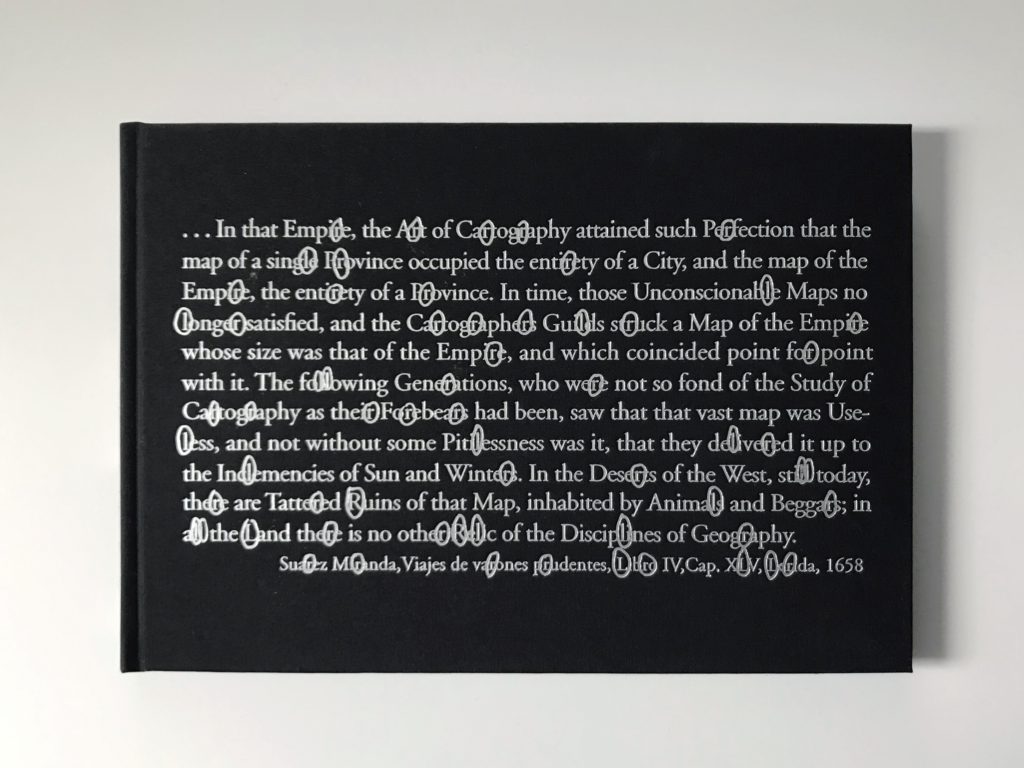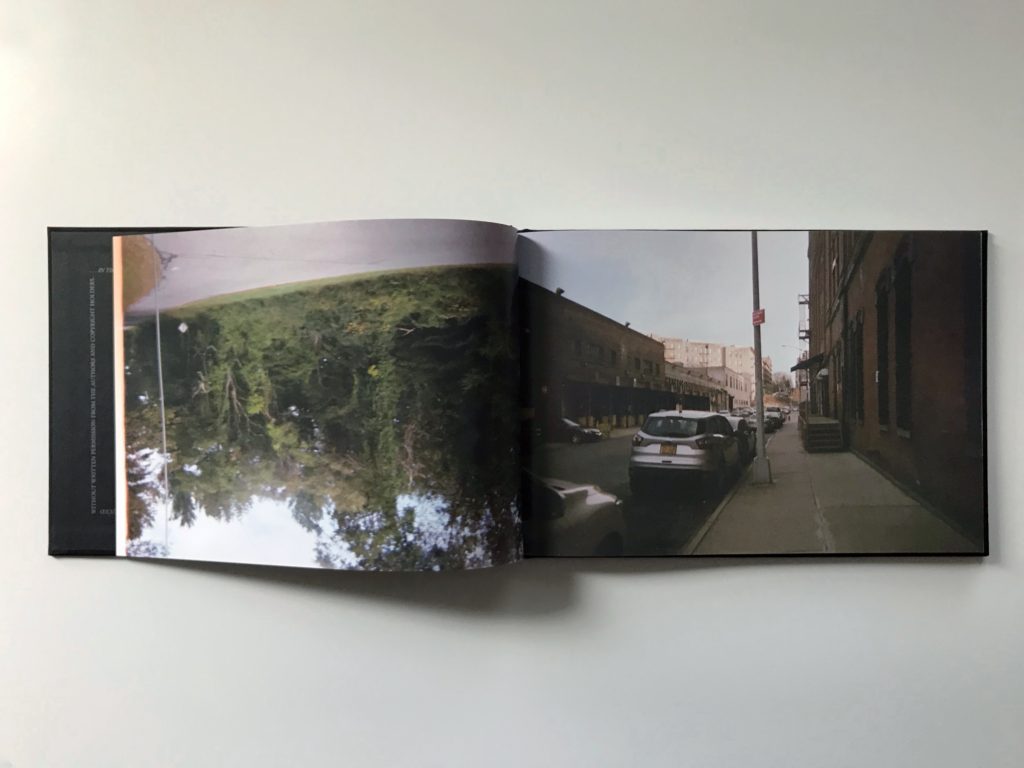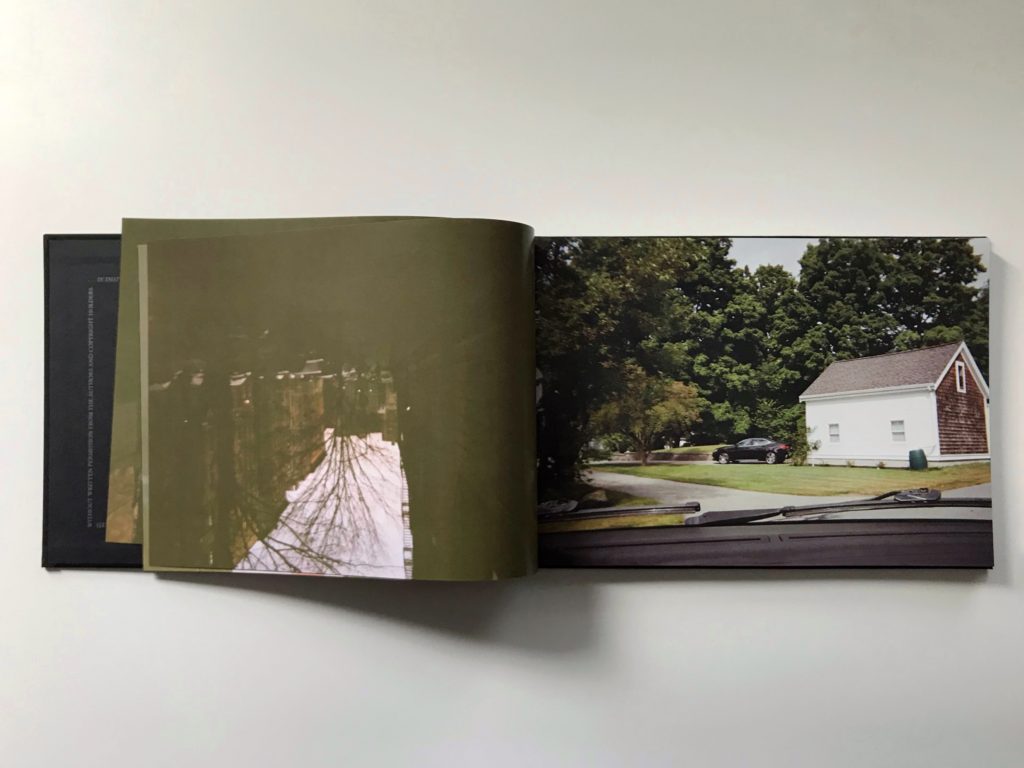Cal Siegel is an artist based in Brooklyn, New York. Drawing from personal history and environment, Siegel weaves through various material and dimensions making works that position themselves in the duality of criticism and celebration of different aspects of his narrative. Most recently, he held a solo exhibition at CUE Foundation titled “I am the box no roof can cover,” which was curated by Sable Elyse Smith. They also have a book titled …In That Empire forthcoming, published by Pacific Publishers.
Below is a conversation about not only works featured in his recent solo exhibition, but also about his practice, childhood, photography, and artists that he thinks about. The conversation took place at CUE Foundation on January 2, 2019.

Jongho Lee: To start off, what was the experience of working with a curator who was also a close friend like? Have you worked with her before this exhibition?
Cal Siegel: Sure, we had never produced anything in particular but have been talking about a book project that sort of got wrapped up with this show for a while, for at least a couple of years. So it was definitely baked in and we’ve been on similar wavelengths. I met her at Skowhegan and hit it off as friends first before we started to realize the connections between our works. So when this opportunity presented itself to Sable and me, it made pretty good sense to us. The overall experience has been great.
JL: The photographs in box at the front of the room are both yours and Sables?
CS: Yes, one set is mine and one set is hers.
JL: They’re the photographs being used in the book?
CS: Yeah, we came to that concept together over a long period of time.
JL: When is the book coming out?
CS: The printing should be done in about three weeks, and we are still working on our release. We’re thinking of doing the release in a month or two. I’ll be out in LA at the Art Book Fair in April with Pacific Publishers, which is based in Green Point and run by two great artists Adam Turnbull and Elizabeth Karp-Evans, who also happen to also be amazing book makers and publishers. Two weeks later I’ll be in a group show at The Pit as a part of ‘The Pit Presents,” a programming they do where they invite different residencies and galleries to take over their space. They invited Left Field Gallery, a gallery out in Los Osos that I’ve worked with before, to do an exhibition.
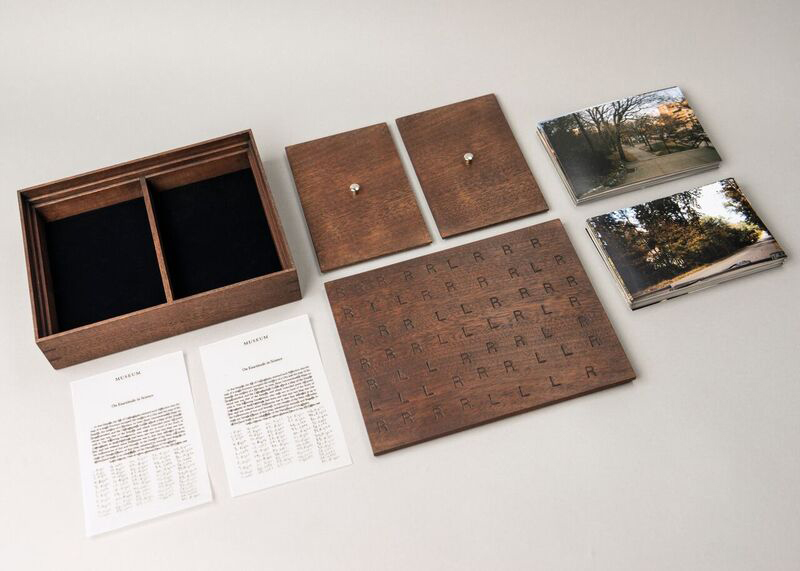
JL: In terms of place, a huge theme in the exhibition, you made a lot of this work in Massachusetts, which is baked into your practice and has a certain aesthetic influence on your works. Is that something you arrived at by making works, or was it a separate element until you realized it was important to the work?
CS: The fact that I made a lot of this work in New England back home in Massachusetts happened totally by circumstance. But there was definitely a shift. It was something that’s been important maybe originally aesthetically, but the shift of when it became a part of my work was when I was able to look at it critically after having distance from it. It was always there for sure, but the critical angle, or at least the ability to think about it in new terms was something that came a little later. It’s always been a part of it.
JL: While looking at your last solo exhibition in MA, I noticed both precision and looseness in the works- a looseness of craftsmanship, along with letting go of sleekness, paired with a conceptual sharpness that could not come without the looseness I just mentioned.
CS: That’s totally accurate. I had a studio visit with a close friend who is a really good painter and a very sharp critic a while ago, and I remember her walking in and saying “Oh yeah, the bad taste of good woodworking.” That’s something I think about a lot. I think this practice started out of pure making and craft. So the further I get into the “thinking” side of it, for the lack of a better term, that letting go of certain craft tropes or the rules of craft in order to arrive at something less perfect helps the work be more porous. I was raised by people who believed in precision craft, so getting rid of that started at the same time I started to think critically of that culture.
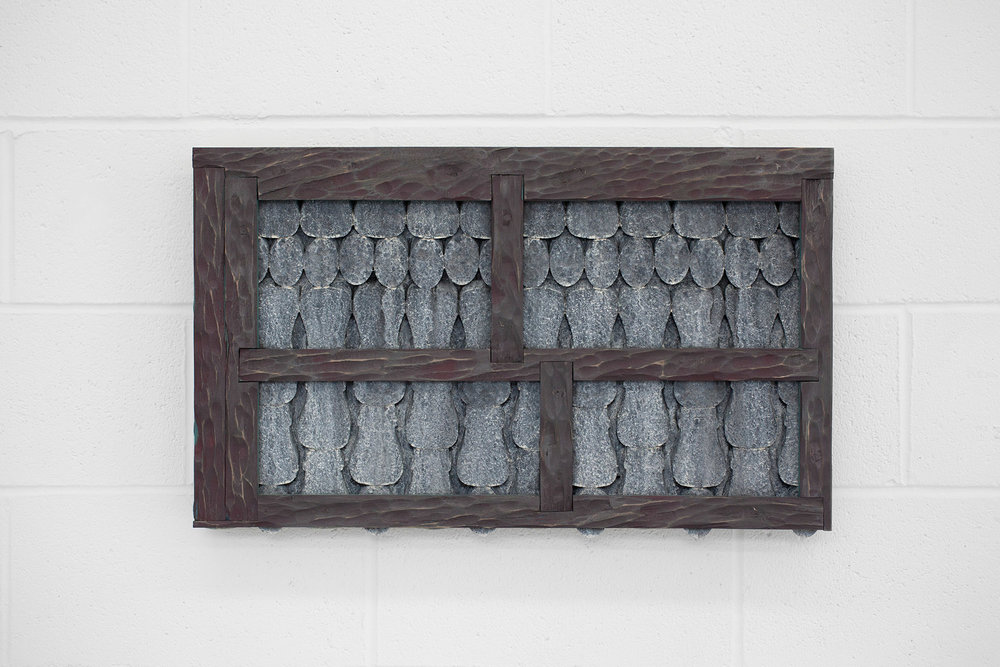
JL: Let’s talk about that. You started working at a woodshop pretty early right?
CS: Yeah, my dad owns a frame shop so I’ve been around that world for a long time. He’s got some people who have been working with him for a long time that are amazing artists, painters mostly. I grew up with people that are like capital P painters. My mom’s dad was also a crazy craftsperson. He was an engraver, a big boxmaker, which is where some of the boxmaking comes in, and was also a gunsmith. He made his own guns, which were really beautiful objects in their own right. So that language, the way he talked about things, or the way my parents even talked about things was around me all the time. There’s a great way that they talk about stuff where inanimate objects have desires without thinking twice about it. For example, “this screw wants to go this way.” There’s a path of least resistance with these objects, and that is the pinnacle of craft.
JL: Which is what you are resisting in these works.
CS: Exactly. For example, in a lot of my wall pieces, or paintings, there are all of these implied joinery, and structural elements that are completely flat and are unable to hold any weight.
JL: And in thinking the way you just described these works, paintings, wall pieces, and growing up with capital P painters, where do these lie for you? And is it important that they lie anywhere?
CS: A constructed painting is an interesting concept because flatness is important, but only against concepts of function, weight, distribution, trusses, and these kind of elements. In that way, the flatness is important to complete the joke or criticism. I definitely arrived at a lot of this stuff from painting, and I’ve made some paintings. I’m also married to a painter, hang out with a lot of painters, and look at a lot of paintings, so I feel it’s unavoidable. In that sense, flatness is important in addressing the architectural, crafty, structural elements without going into that dimensional world. In that sense, they are constructed paintings.
The concept of flatness is addressed in so many ways in this exhibition. Not only with the constructed paintings, but with the photographs and even the big structure in the room. There’s a mindfulness to the scaling that’s happening to early colonial American architecture.
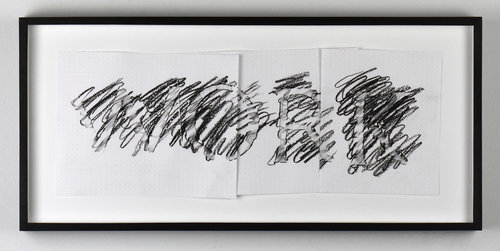
JL: I like the different forms of play involved with the flatness, for example the dimensional difference between your sculpture when photographed in front of Jonathan Crowley’s house in and the actual object or the recreation of relief through the rubbing of the word “Work” on Marx’s grave on a flat piece of paper. A lot of the works here seem to arrive where they depart, which to me is one of the most fascinating aspects of this show.
CS: We can use the metaphor of a product’s triangle of quality, price, speed and a customer, who gets to choose two. If I take the elements of dimensionality, space, and scale, or other aspects of my work and choose two of them for every work, then I am still dealing with the same world, but tackling different aspects of it with different outcomes. That’s the connective tissue of all of this stuff.
JL: Has photography always been an integral part of your practice?
CS: It hasn’t always been an integral part, but it’s something I’ve been doing since high school. I actually majored in photography in college. It’s a really good thing to learn about because we deal in images more than anything else now.
JL: I ask because I was talking to Dan Herschlein about how certain works in an artist’s practice act as keys to their practice as a whole. That’s how I feel about Witch house drive by, because it touches on so many different parts of your practice. It reminds me of Jacob Riis’ How the Other Half Lives and the criticism of Riis as a voyeur from another class that ultimately wasn’t able to change anything.
CS: There’s also August Sander, who’s kind of the german version of that, and his work got caught up with fascism from just photographing everyday people.
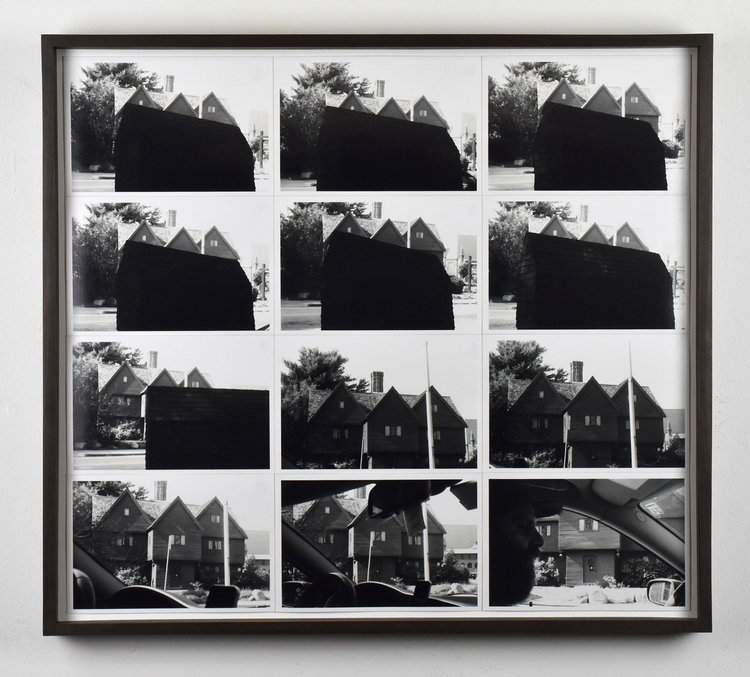
JL: Right, so this type of work lends itself to critical backlash even when the work comes from the purest of intentions. It’s even more interesting to look at in the current political climate. How do you reconcile that yourself, as someone who is dealing with the underpinning institutional issues? I’m not sure I’m doing a good job explaining myself.
CS: I get where you’re going. It’s a fine line between celebrating and fetishizing this culture, while at the same time criticizing the history of it. I feel the most interesting kernels are where you’re caught between a celebration and a criticism. Sable just did a performance event titled C.R.E.A.M at The Kitchen, and Jibade-Khalil Huffman and Simone White did a kind of critique of trap music that was also a celebration. It just kept going back and forth and was floating in this weird in between space.
JL: Did it work?
CS: Yeah! It was incredibly interesting, and as a viewer, at first you’re thinking, ‘what do they as the performers think?’ and then you’re asking ‘does it matter what they think?’ But I guess I’m a little too personally connected to this place that I’m talking about.
JL: Which is the Northeast?
CS: At this point it’s a conglomeration of what I imagine that place to be. But to be caught in between that reverence and criticism is what I find to be the sweet spot. I’m trying not to be too fetish-y and go into that world. The movie The Witch is a perfect example. It’s such a beautifully shot movie, amazing set design- they really nailed everything. You even get caught up in the choice of language that they decide to use, but the underlying theme of the whole movie is incredibly violent and fucked up. So to be somewhere in there.. And I’ll say Jacob Riis’ intentions were probably a little purer than mine- pure intentions are problematic. I don’t think the series of photographs are a celebration of that house.
JL: Can you walk me through some of the architectural tropes that you’re working with?

CS: hung bunting is one of the first shaped ones that I’ve made. The wall pieces are such a long process in both the time it takes and the number of decisions I have to make. This one started with the overall shape and the notches being cut out, so from a formal perspective it was an interesting wrench to throw in and work up against, and made for a more interesting layout for the scaffolding wood used in the front. This one references a building more than an architectural detail.
JL: How many versions of the shingled structures are there?
CS: I showed one in California, one in Mass, and I have one that I made that never made it out of the studio, then there’s Eight Gables for Mickey that’s in this show- four of them total at this scale.
JL: Are you thinking about one reference point, or just the general architecture?
CS: Just general architecture- definitely not a specific building. I used to have crazy dreams as a kid about particular houses. They were real houses and I’d seen them, but I never knew anyone that lived there or what street it was on and I feel like that’s been a lot of the source material- going back and trying to remember the house in the dream.
JL: It was the same house every time?
CS: Yeah, it was crazy. Like over and over and over. It was a house that I’d driven by as a kid and I could find out exactly where it is. I’ve thought about going up and knocking on the door, but at the same time, I don’t really want it to be a “real” house.
But also, I have some close friends that I grew up with that lived on a farm from the 1600’s and family in Maine that live in old houses so I draw from those places as well, but not one specific structure in particular.
There is a really good one that’s referenced in the title of this piece “Eight Gables for Mickey,” which is a house in Salem called the The house of the seven gables that has this shingle style architecture that groups and stacks forms in way that doesn’t make sense together but gives it an organic form that I reference as a source. Nathaniel Hawthorne also wrote a novel based on the book.
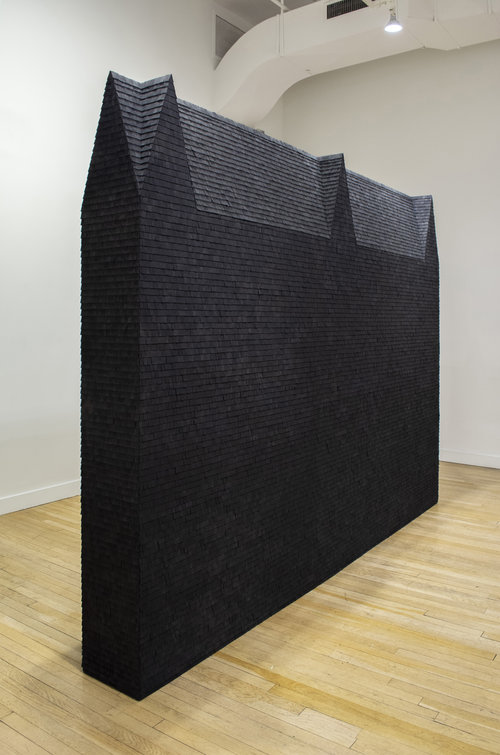
JL: It’s interesting to think about certain houses and how they imbue magical qualities like the one you just mentioned. Your pieces simultaneously break down that magic, but also keep it alive by focusing on real elements of these structures that enforce those magical qualities. It’s a fine line of “Holy shit, look at this,” and “Look away, this is horrible”
CS: At some point, Dan was talking about how these houses, or spaces in general collect energy like a battery and that’s just the nature of it. There’s no fighting it. As artists I think we are trained to have some sort of sensitivity to that kind of energy.
JL: I was talking to a critic about trends in critical and art theory and how certain trends cycle and she mentioned that the concept of magic was reemerging.
CS: Totally! I was getting way into chaos magic and the concepts behind it, and that’s where the idea of the book started to morph too. The map territory relationship was there, but the concept of creating meaning out of nothing. It’s art, but it’s also magic to a certain extent. To be able to find profound meaning out of nothingness.
JL: I want to backtrack to this box, and talk a little more about the text, how this relates to the similarity between your and Sable’s practice and what you’re addressing.
CS: Sure- it’s an experiment of subjective cartography. It started originally as a game that we would play as kids. I grew up in a place where there was not a lot to do, so when you get your license, it’s a pretty big deal. I’m sure you’re familiar, having grown up in the suburbs. When we got our license, my friends and I would play a game where we pass a piece of paper around and make a list of left or right turns. With that list, we would get in the car and follow the directions that we just made to try and get lost, waste a little time, learn something new about the neighborhood, or whatever. It also seemed like a good way to connect with other people over a place.
The text we ended up using as source for the directions was a Borges story. I got into the map-territory relationship concept, which basically states that the map is not the territory. It starts to get into semiotics too in a way, which is a totally different ball game. It’s a short story by Borges that he attributed to an explorer from the 1600’s, but it’s just a story of a cartographer that made a map the size of the territory, and ended up being a useless map because it just covered the whole territory.
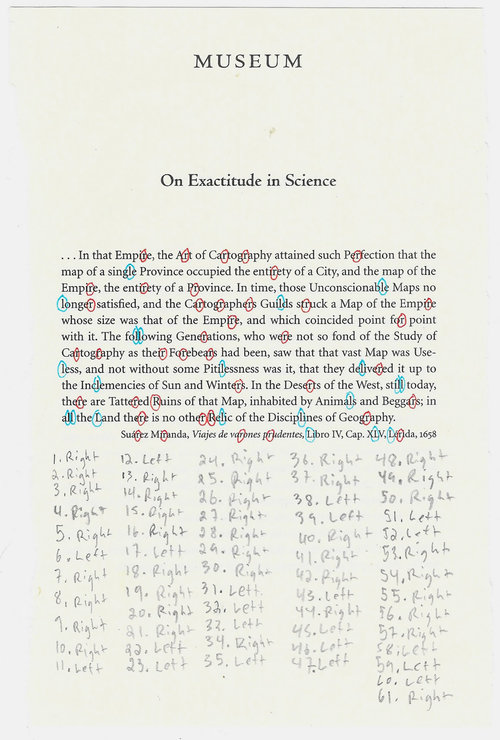
JL: Do you know that Steven Wright joke?
CS: No, hit me.
JL: It goes: “I have a map the size of the United States.. I spent last summer folding it.”
CS: Haha, exactly. He’s got another one ‘It’s a small world, but I wouldn’t want to paint it.” It sort of plays into a similar absurdity. We decided to extract our own meaning from the Borges story by going through and circling every L and R in order and creating a list of directions. Sable enacted hers taking a photo at every turn in Harlem walking from her apartment, and I enacted mine driving from my parents house in West Newbury, Mass.
The idea of making a box to keep these photographs aside from it being another tribute to my upbringing, was the precious, keepsake aspect of it. It’s always nice to flex those crafty muscles when it is appropriate and makes sense. I think it’s really important- it should be sculpture, painting, photography, and boxmaking. There are a lot of artists that have made really good ones like Richard Artschwager and H.C Westermann. There’s something nice and precious about it that lends itself nicely to this particular project.
JL: Learning about all the elements of this project reminds me of Witch House Drive by by again, and I’m kind of thinking of it as an expanded version of those photographs. The performative aspect becomes less about forced superimposition and turns more insidious.
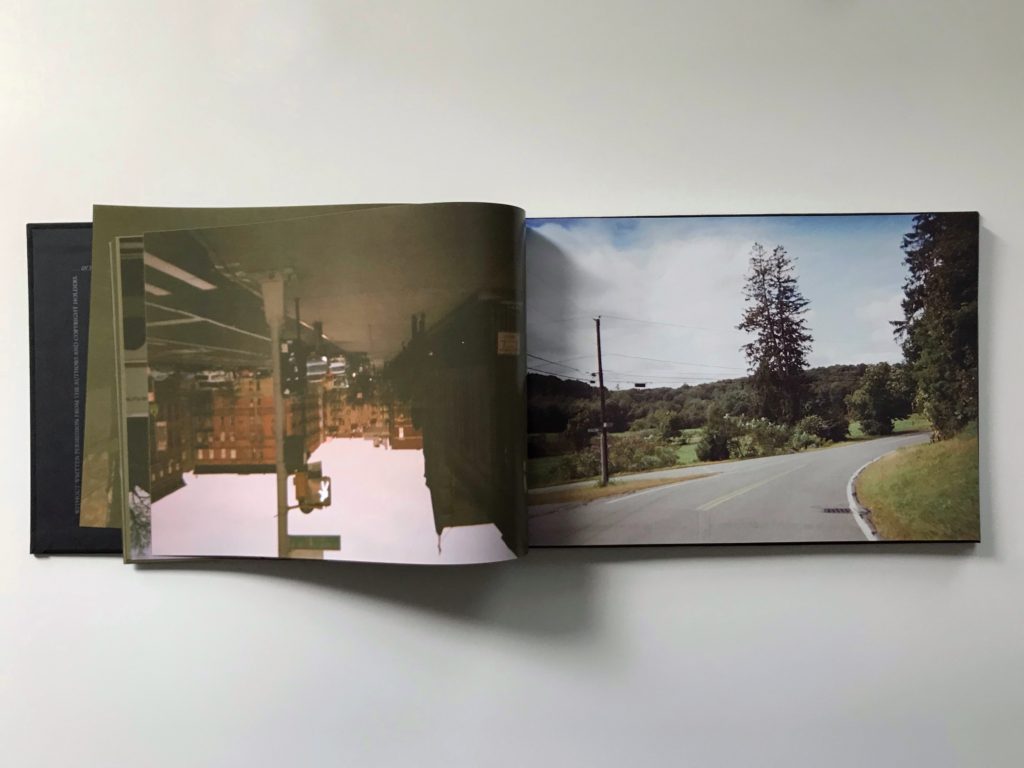
CS: A lot of artists I looked up to as a younger artist were sculptors whose final product was a photograph.
JL: What are some examples?
CS: There was an exhibition when I first moved to New York at the MoMA titled the “The Original Copy” and it was photography of sculpture. Bruce Nauman is a huge one, Charles Ray’s plank piece… It was so cool to be able to see the Hammons photographs at the Mnuchin show, which I don’t think are shown a lot, but to see the photos of those shoes thrown over the Richard Serra sculptures was really cool. I love William Wegmen too.
JL: One of the first things I remember about Hammons were the snowballs on Bowery.
CS: Right, it’s the residue that we’re left with- there’s something very powerful about that. Maybe that’s where photo ends up in my world- as documentation. When I was younger and way more into photography, I loved Cindy Sherman’s work. In a lot of ways, she’s photographing sculptures, creating this whole thing for one image.
JL: Even thinking about time as a sculptural element and the self as a subject, photography just becomes a tool for documentation. I think she’s one of the most elegant examples of artists who have embraced their age.
CS: I don’t feel any particular way about her any more necessarily, but that as a concept has always stuck with me. I have a really good friend who has a show up right now, Rachel Granofsky, at Rachel Uffner– she’s a really great photographer. She creates these insane installations in her basement that are meant to be viewed from one angle. They exist as one image, but there’s a lot of effort put into that, and I’ve always admired that. I mean even Gober’s photographs. I think of photography too as a map or key to there rest of your practice in a way a sketchbook is.
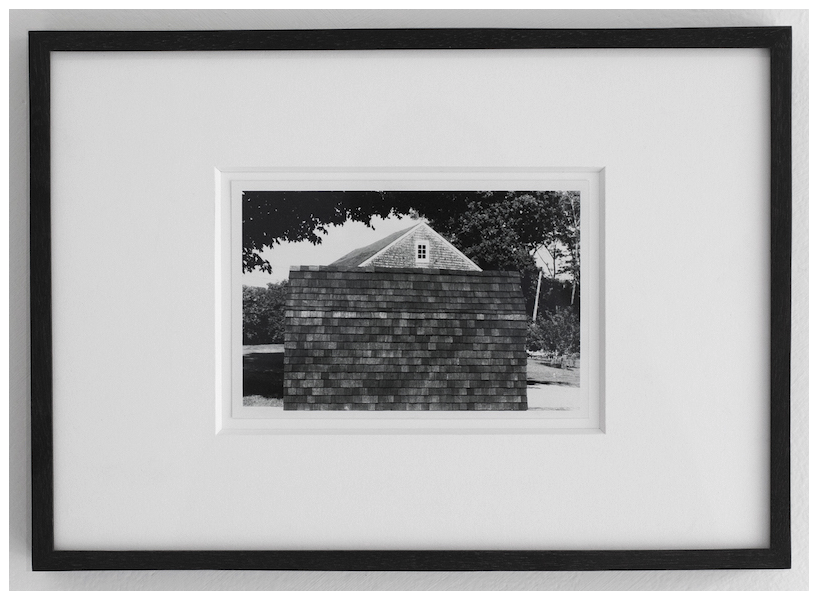
JL: Or a really dense synthesis.
CS: Mhm. There’s something really nice about the chance element behind just firing off three rolls of film. All the photos in the box are done on disposable cameras, all the other photographs I take are just by a crappy 35 mm camera that I have.
JL: Do you develop them yourself?
CS: No, when I had access in college I used to, but the quality of the photograph isn’t very important. I’m not concerned with color quality or the camera fetish stuff. I feel like I found my camera, and just stuck with it. It feels like an extension of myself and is also a low stakes way of looking at your own stuff and sort through it later. The latent aspect of using film is really important for me too- I’ve never had any luck with digital images.
JL: Is that because of the immediacy?
CS: Yeah, I need a bit of distance and time from this stuff. I also need to look at them physically and flip through them. That’s a picture I took two years ago and never really considered it before the wall pieces started to get made.
JL: That’s not a picture of your sculpture is it?
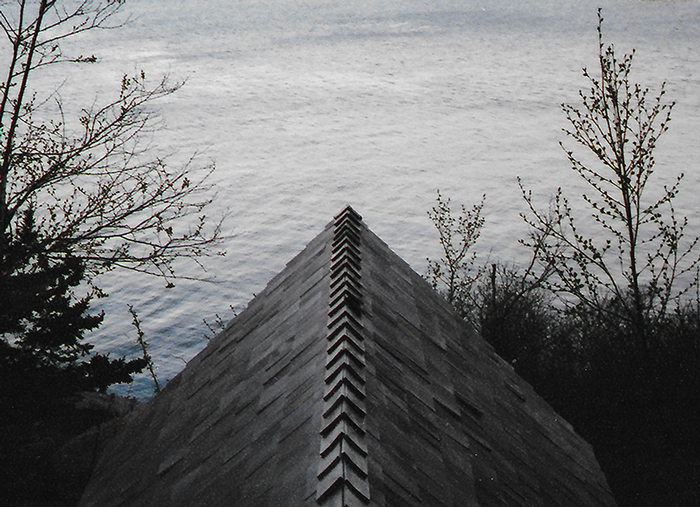
CS: No, it’s just a picture standing on a roof in Maine. There’s a wonderful Andrew Wyeth painting titled “End of Olsens” which is a painting from the perspective of him standing on top of a roof. That painting fucked me up. There’s something so wrong about that perspective, especially as a painting. It’s psychologically disturbing. It’s a beautiful sunny Maine landscape standing on top of this house looking at this cove, but there’s something so wrong about that perspective and I feel like that played into some of those house dreams too. You know when you’re dreaming and all of a sudden you’re standing on a house! Or have a perspective that’s totally irrational.
JL: It’s funny because there’s a serenity to your photograph. More than that, a meditative quality to it.
CS: For sure, and I would not say that I succeeded in mimicking Wyeth’s painting.
JL: Was that the intention? Or were you just thinking about that painting.
CS: I’ve always wanted to make something like that painting so when I took the picture I was thinking about the painting, but I’m not sure that I would ever be able to get there. He’s a good painter and again, he’s someone where once you get away from the pure celebration of his skill and into the fucked up aspects of his subjects, it gets more interesting. That’s a transition worth diving into.
JL: Would you say that transition started at Skowhegan? Or were you dealing with it before that?
CS: Probably before that.. I wish I could pinpoint that critical turn. But I do remember as a kid going over to my friend’s house which was a 1600’s farmstead basically, and thinking “This place should be scary, but for some reason I feel really safe here”
JL: Was it your friend’s family that made you feel safe?
CS: No, it was whatever energy the house had cultivated. For example, I never felt weird going to the basement alone at night, but in my parents’ house which was built in the 70’s I’m still scared to go down their basement. It was the energy that made it feel okay at my friend’s house, but that’s not to say that everything that happened throughout history there was okay. But trying to unpack things like that. Maybe it was also moving to California for school? The distance might’ve helped since there’s not much out there that’s very old.
JL: Would you ever go back there?
CS: I love visiting, but I would never move back there. I definitely feel an emotional connection to the northeast.
Before I forget, I want to tell you this story: when I was nine, the same folks that lived in the old farmstead took me on a sailing trip and they dropped a couple of us out to this place called Hog Islands, Ipswich and dropped us off. It was an island of sand so you couldn’t really get into much trouble or get lost, so he dropped us off and told us he’d come honk the horn in a couple of hours when he was picking us up. So we’re running around through these sand dunes, and we come over the rise of this hill and they’re filming “The Crucible.”
JL: No shit.
CS: Yeah. So it’s this whole New England village, all the people in full costumes, and we were just so confused and probably ran away. But that aesthetic is burned into my brain forever. Especially the movie set scale, so you’re dealing with all of these huge architectural and cultural signifiers but on a scale of a film where you have to look at things from a certain direction for it to make sense. So maybe that was the critical turn, before I even knew it.
JL: I love that movie. Did you know Daniel Day Lewis is married to Arthur Miller’s daughter?
CS: No way. Were they married when the Crucible was being filmed?
JL: I’m not sure, but they’ve been married for a long while now.
CS: I haven’t watched it in ages, but I want to again. Winona Ryder’s in it and Daniel Day Lewis kills in that movie. They actually just sold John Proctor’s, who Daniel Day Lewis plays in the movie, real house. Maybe it’s still for sale.
JL: I’m surprised it’s not a national landmark.
CS: I know, I wonder who owns it now. It’s funny too, because the images on Zillow look so wrong. They had done some amenities to it so it became this weird in between house that was historically accurate but also has an induction stove vibe. The ceilings are at 7 feet, and everything is skewed like a fun house.
JL: One of my favorite parts about this show is physically walking through from start to finish and how considerate you were about what information and what order to give away said information.
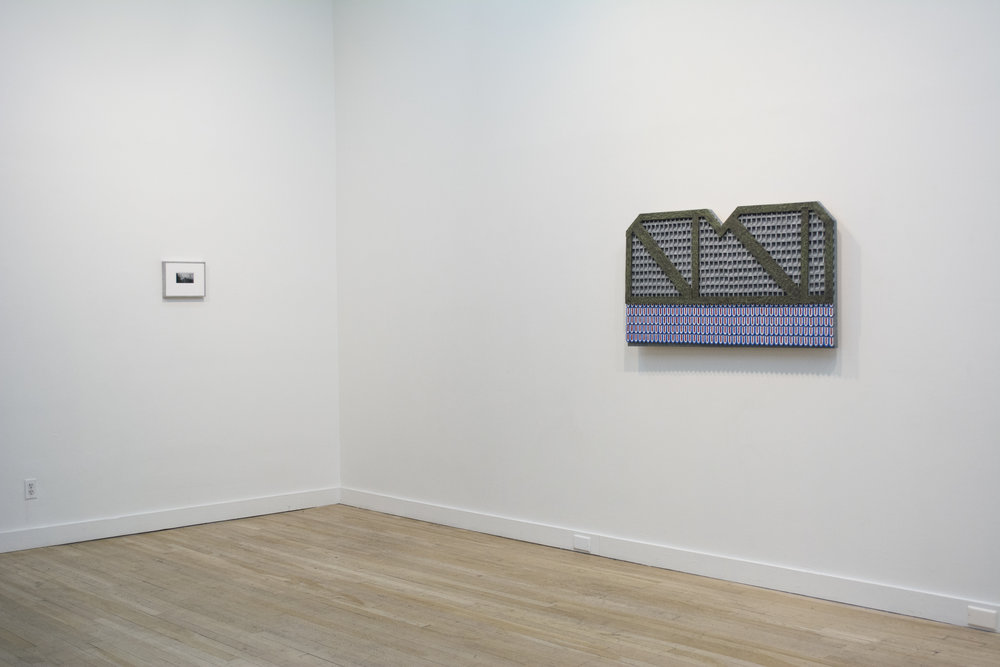
CS: It unfolds nicely, and it’s something I aim for whenever I have a chance to make a complete exhibition like this- to develop an arc, but also not to stick too much to it. Like I’ve never been able to work serially. That’s when it starts to make sense. You’ve been working on all these disparate things that are clearly connected but the opportunity to show them affords you the ability to figure out how they connect without them having to be formally identical. I’ve never been interested in finding the nuance between formally similar works.
JL: It’s not as important for this work.
CS: Not for me, but sometimes it is. There’s a tendency to push young artists into the realm of seriality to see that nuance between like things.
JL: Do you think that’s because of the proximity to the movement of artists who have almost obsessively focused on seriality?
CS: Definitely, but then I think there are canonized artists now who have shirked that and don’t have to deal in those terms, which is liberating because it’s definitely not for everyone. I don’t find it boring to look at other people dealing with it, but just for myself I can’t do it. I’ve tried. Even these boxes for the photographs, making eight of them was grinding. The first one was fun, but that disappears quickly.
JL: Is there only one drawing in the exhibition?
CS: There is. I’ve been working at a different scale for the previous drawings, and the one here is bigger than the previous ones. They started as a way to flush out ideas for the bigger sculptures without making models. They’re made from rubbing the surface of the shingles and then re-orienting. What became interesting is that you can’t correctly mimic perspective with that surface. For one of the sides of the structure to be correctly mimicked in the drawing, the shingles would have to be angled.

JL: How do you fudge that?
CS: I don’t, which is what became interesting. Because the perspective acted as a dead-end. There’s another aspect playing with dimension and flatness that’s present in Eight Gables for Mickey
JL: This is where artist practice gets interesting, where you create roads in your works and you can get lost at every turn and angle.
CS: And the longer you stick with it, the more generative it becomes and it becomes a beautiful practice of trust in yourself to see something out like that.
JL: Where dead ends become solutions to different problems.
CS: Exactly. That perspectival dead became something incredibly interesting and then I start to see it in these bigger sculptures. In the presence of one of these things, there’s a sense of dimension and flatness at the same time and perspectival inconsistencies through the scale shifts. That’s really interesting to me. At once, it humbles these colonial structures that are very imposing and takes them down a peg or two, but at the same time maintains an inability to penetrate or enter into them.
There’s also a general unification of form through the process of the same act over and over again. At the last instance, the unification happens. It’s a process, and you just have to trust it. This thing took me two months, just putting those little shingles on there.
CS: Where do you get the doll shingles?
I used to order them direct from this miniature company and then I figured who the wholesaler was. I developed a relationship with the wholesaler, who ended up being this 90 year old woman in Georgia- she just retired. We used to chat on the phone, because she didn’t have an e-mail or anything like that. She never asked me what I was making- she knew I was an artist, she knew I didn’t have a tax ID to be selling these things, and she knew I was buying 90,000 shingles at a time, but she never questioned what I was doing with them, which I loved. We would just shoot the shit about her family and what she would do in retirement. I’m gonna miss her, but I’ll find another way to enact that same feeling.
JL: Georgia reminds me of the type of preservation that we were talking about with John Proctor’s house and also of the historic districts of older houses in other states in the south where you’re not allowed to do major renovations on these houses. Does that kind of preservation resonate with you when you’re dealing with some of this historic architecture?
CS: Do you know the photographer WIlliam Christenberry?
JL: I do not.
CS: I think he passed away 3 years ago maybe? He studied under Walker Evans and photographed structures in Alabama where he was from- A lot of it came from that text that Walker Evans did the photographs for, Let Us Now Praise Famous Men which was a kind of WPA turned art project. But his interest in that kind of historical preservation, what you were speaking to, was to photograph these same structures every year and document the entropy. So they are these beautiful arrays of photographs of these buildings collapsing.
JL: That also brings to mind Robert Smithson– entropy, Passaic..
CS: Sure, totally. And that project at Kent State which I found really interesting too, where he let the shed collapse after he buried it. So if we can talk about a relationship between the historical preservation and on the other hand, the degradation of the structures, I think that’s where someone like Smithson or William Christenberry comes in. Or somebody like John Divola too in the photo world- super interesting take on the degradation of those house structures, and giving them up to nature… I forget what the question was.
JL: It had to do with preservation.
CS: Right, structures and preservation. I guess I’m not necessarily interested in historical preservation, but I am happy to have the opportunity to see things as they were originally. So somewhere in between there.
JL: All this reminds me of James Casebere’s works as well, especially those earlier photographed paper architectural model.
CS: Yeah those were super cool! He’s an interesting one… He had a two person show that was really big for Glen Seator, who was amazing. I don’t know if people are thinking about him anymore but he would pull out the office of the Whitney Museum, studs and all, and tilt it up on its side. He died falling off his roof.
JL: No way.
CS: Yeah. It just blows my mind.
JL: Talking about artists like these makes me think about how hard it is for an artist to retain a critical stance at this time where so much fluff exists in the art world. I’m always taken and admire people that are willing to explore cultural phenomenons that aren’t the most colorful or eye-catching but a part of me thinks that taking things that we have and looking at it from all angles is still at the core of artmaking rather than just producing new things that become distractions or props.
CS: I also think there’s huge value in Sisyphean projects.
JL: Which describes art practice in general, but yours especially.
CS: I think it should describe more people’s practices. There’s a built in trust that you need to have in a practice that immediacy can never address. It’s a marathon, not a sprint. There’s also a fetishized version of such practice, and that’s why we’re so drawn to these artists who accomplished all these great things and died really young. There’s some sense of mystery in the project still, but the work is undeniably on its way somewhere. Art practices just don’t feel as thorough as I want it to be. Not as they used to be, because I don’t think that’s fair.
JL: I think the practices exist- they’re just not being seen or given a chance to be seen. What you said about young artists leads me to Francesca Woodman, who is one of my all time favorites. She dealt with something very human, and about the type of practice that you describe.
CS: She’s amazing, and this is something that studio artists quote a lot but applies to Woodman in particular is Nauman’s idea that if I’m an artist and I work in a studio, then everything I do in the studio is art. At a certain point, you can follow threads in a studio that don’t seem valuable but are worth following. She’s a great example of someone who dove into that stuff and really believed in the potential. It’s scary. Rent’s expensive here. People sometimes think that the practice of making art is supposed to be fun or zany, and it’s not- it’s gnarly.
JL: I remember interviewing Dave Hardy a while back and one of the last questions I asked was if it was a choice for him. He said yes, but a difficult one; it’s a lot of time spent alone doubting yourself, and a lot of time knowing that none of it might pay off, which is the downside of that romanticism of being an artist.
CS: Part of the farce is that you know right from the beginning that this is what you have to do- that’s bullshit. But you do get to a point where there’s no turning back.
JL: I totally agree with that. And there’s never a right call.
CS: No there isn’t. It’s that joke where a person decides to swim across the English Channel, they get halfway there, get tired, and swim back. It gets to that point. When people say “I have to do this,” it’s not because they were born or fated into this, it’s because they’re too far in. It’s the harsh reality. But also, I wouldn’t have it any other way. I’ve racked up more credit card debt and U-haul trips than I’d like to and don’t have a lot to show for it, but it was worth it.
When you see someone who you know doesn’t necessarily have the means to do something and they did it, and it’s in a gallery space and it’s insane, that’s inspiring. We’re all making a lot of sacrifices to get big things into small spaces.
JL: It’s a way of showing dedication to yourself, that belief in yourself that you’re talking about. At a certain place, it’s not about pulling it off anymore.
CS: Exactly, it’s for yourself. And then figuring out the storage when the show comes down.
______________________________________________________________________________
Cal Siegel is an artist based in Brooklyn, New York. His newly published artist book, …In That Empire, co-created by Sable Elyse Smith and published by Pacific, will be available April 1st. The book release will take place at Mast Books on May 13th. The book will also be featured in Pacific’s booth at the LA Art Book Fair. Siegel will be featured in a group exhibition The Pit Presents… Left Field at The Pit in Los Angeles. Below are more photos from the book.
